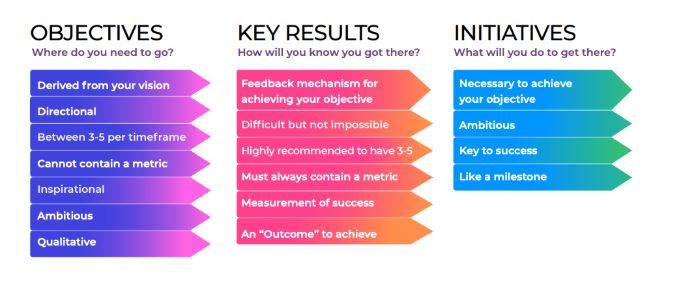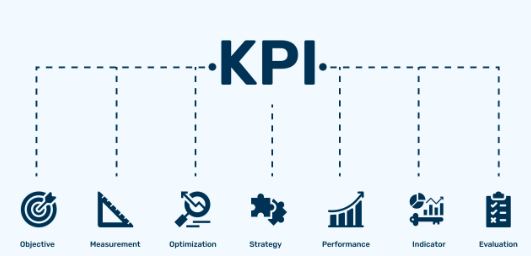Introduction to Objectives and Key Results(OKR)
The objectives and key results help set individual, ambitious, and measurable goals that support everyone to work towards the common goals. It makes sure that it provides greater results. The OKR is used in various sectors such as personal development, industries, business, and nonprofit organizations. In OKR, the objective indicates the achievement of the goal. It ensures the goals are crafted well and work towards accomplishment. Results indicate the measurable outcomes that are produced. The OKR is a powerful tool to enhance development and ensure proper alignment with the goal. The key results are generally measurable and quantifiable. Moreover, there are specific deadlines that are set with a significant amount of progress to achieve.
Examples of Objectives and Key Results
For example, a company has established a bold objective for the recognition of the brand. To measure and achieve the goal, they have defined four key results. That includes increasing media engagement by 20%, launching a reflection program in a month, expanding social media reach in two weeks, and leadership program publication in one week (Sultan, 2022). Both these objectives and key results were designed to drive meaningful progress towards the company’s visibility and reputation.
For instance, the marketing team has set a promotional channel for marketing qualified leads. Specifically, to track the progress of three key results: increasing e-mail marketing from 100 to a higher target, conversion rate of landing pages with a certain amount of percentage, and achievement of a specific growth rate in social media lead generation effort. Finally, these key results provide measurable targets to accomplish the goal.
Objectives and Key Results(OKR)

Key Performance Indicator
The KPI is a measurable progress towards the goals of the organization. Unlike the performance matrix of individuals, it focuses on business demands and operational activities. It is a structured and standardized approach to managing business performance. Moreover, it helps businesses to understand the aspects related to specific objectives. These are quantifiable and help to drive decisions (Twin, 2025). The high-level key performance indicators indicate parameters such as customer satisfaction, revenue growth, and profit margins. The low-level key performance indicators indicate return on investment and target sales.
Examples of KPI
The example of KPI indicates the sales conversion rate, which is the percentage that converts into paying customers. This is a measurable experience. Sales revenue rates the sales in a particular period to track the business growth. Customer retention rate where it remains good customer service and satisfaction percentage (Amani Undru, 2024). Employee turnover rate indicates organizational information about employees leaving in a particular time frame. Social media engagement rate, which indicates elements such as likes, shares, and comments, improves high engagement.
Benefits of OKRs
Flexibility
Unlike traditional planning systems, the OKR is shorter and adjustable. Generally, they are set for a shorter period with the requirements. Also, this approach minimizes time spent on planning and allows the team to work in a flexible cycle.
Focused team
Basically, OKR promotes key results and objectives with a streamlined approach (Muslimin, 2023). Also, supports everyone to concentrate on the prioritized tasks and urgent tasks.
Engaged employees
It promotes both transparency and boosts motivation towards productivity (T, Thinyan, Ghawji, Shehri, & Aramco, 2022). It not only engages but also enhances the performance with overall satisfaction.
Better team alignment
It promotes false functional alignment and also connects every individual of the team to work together towards the goals. Moreover, it ensures everyone is on the same page.
Benefits of KPI’s
Strategic planning
It promotes a clear picture of strategic goals. In addition, it supports businesses to progress the plans and monitor the adjustments towards long-term achievement.
Enhanced communication
Generally, KPI is a common language for discussion among all the people. In case of any meetings and communication within the department, it progresses the issues and works toward the success.
Focus and alignment
Promotes both data-driven decisions and data-driven insights to make informed decisions. Moreover, it understands all the strategies, resources, and plans of action to complete the better outcome.
Enhanced motivation and engagement
Basically, it helps to monitor the team goals and motivate the employees to achieve the target. The team monitored, engaged, and boosted morale.
Key Performance Indicator

Combination of OKR and KPI
Define the strategic goals and objectives the OKRs are used. These are helpful for vision and the vision of the organization. The KPI indicate measurable indicators where they work in certain directions. Both of them push together to drive innovative changes and also operations that establish performance. The data-driven insights are offered with KPIs, a provider that promotes tracking of key results and provides real-time data to progress. The OKRs promote strategic frameworks and monitor the effectiveness of the strategic goals. Both of them create a dynamic setting for tracking the ongoing performance and attaining organizational success.
Conclusion
OKR applies to new strategic goals and defines measurable key results. There are clear indicators of success, whereas KPI provides standalone metrics with ongoing performance. The OKRs are useful for successful measurement in a specific time frame, whereas KPI provides specific activities continuously, such as customer satisfaction and sales generation. The OKR involves leading and measuring the progress towards ambitious goals and measurable outcomes, whereas KPI’s are monitored regularly to help the organization, but it is not flexible. To conclude, OKRs are particularly defined for designing new goals and measuring the goals towards the success, while KPI’s are focused on improvement of continuous performance measurement and outcomes.
References
Amani Undru. (2024, Mar 18). Top KPI examples that every business needs to measure. Retrieved from Thoughtspot: https://www.thoughtspot.com/data-trends/kpi/examples
Muslimin, A. (2023, Apr 28). Understanding Objective and Key Results (OKRs) and The Benefits for Your Company. Retrieved from Ekipa: https://ekipa.co/insights/articles/understanding-objective-and-key-results-okrs-and-the-benefits-for-your-company/
Sultan, W. A. (2022). “KEY PERFORMANCE INDICATORS (KPIS), KEY RESULT INDICATOR (KRIS) AND OBJECTIVES AND KEY RESULTS (OKRS)”. Kuwait Chapter of Arabian Journal of Business and Management Review, 11(04), 147-157. Retrieved from https://www.arabianjbmr.com/pdfs/Arabian%20Journal%20of%20Business%20and%20Management%20Review%20(Kuwait%20Chapter)_KD_VOL_11_4_2022/2_ajbmrkd_11042022.pdf
T, K., Thinyan, A., Ghawji, H., Shehri, A. A., & Aramco, S. (2022). What are OKRs and KPIs and can they Coexist within an Organization? International Journal of Innovative Science and Research Technology, 07(08), 176-179. Retrieved from https://ijisrt.com/assets/upload/files/IJISRT22AUG054.pdf
Twin, A. (2025, Jan 24). KPIs: What Are Key Performance Indicators? Types and Examples. Retrieved from Investopedia: https://www.investopedia.com/terms/k/kpi.asp
Keywords
OKRs, KPI, Key Results, Measurable, Business Demands
Relevant Articles
Kotter’s Eight-Step Model for Leading Organizational Change
Six Sigma’s Impact on Process Improvement and Quality Management
Read More about the Topic
Do objectives and key results solve organizational performance measurement issues?
